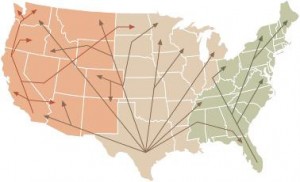Of Human and Wildlife Migration


By Jose Gonzalez, NewsTaco
During a conservation conference I was listening to work being done on habitat connectivity, which helps protect wildlife migration corridors. They are essential habitat linkages for species that migrate or simply need large areas to roam—for example, mountain lions, wolvers, and deer.
In this specific case I was staring at a map in California that displayed the conserved habitat and lines showing the movements of collared animals with GPS tracking. The point was clear, where there were protected habitat linkages, animals moved, not being stranded on little islands of habitat.
As I stared at those movement patterns, to my mind came another movement and migration pattern, that of migrant farmworkers.
I am of course not suggesting we “collar” a migrant worker—that is as offensive a thought as any; especially given the hard work farmworkers perform. But it is certainly of value to look at the comparison of what it means to be aware of these human migration corridors, how they may be “protected”, and connections to free trade and immigration.
Some of the main points in immigration reform revolve around “what do we do with the people already here?” Part of that question, I would say, arose from efforts to “secure the border”.
Though we could delve into more specifics, one general point that is often overlooked is how the “secure the border” effort in a sense cut off migration patterns for many migrant workers that worked in the US during specific seasons and then migrated back to Mexico. With those movement patterns blocked by border wall, migrants found it more difficult to travel back and forth and instead stayed put in the US, sending for their families in Mexico—ironically increasing the number of undocumented migrants. Another irony is that although Mexico and the US have strived to have an open border when it comes to trade (NAFTA), there is much less flexibility when it comes to the movement of people.
But even within the US, there are key migration patterns of people as they move with the crop-picking seasons from the Southwest (especially Texas) up the West Coast, East Coast, and the Midwest.
One cannot propose to “protect” these migration corridors in the same ways that one protects wildlife linkages. But if ones sees how necessary many of these human corridors are to the people that use them, and the associated economic activity, it should help as a lens in the immigration debate.
First, to recognize that these migration corridors exist and that they have value. Second, being necessary, they need to be incorporated in meaningful ways into comprehensive immigration reform. In many areas, farmworkers were left out of basic labor regulations (just like domestic workers) so they do not have the same protection as those of us working in a warehouse or an office. They cannot be neglected in the process, simply seen as an add-on, or not as valued as those for “high-tech visas”. Third, that in arguing for a “better border wall” one should recognized the unintended effects of those efforts. Interestingly enough, the border wall does not just stop human migration—it also severely cuts wildlife migration, bringing us back in our comparison.
So as we continue with the debate on immigration reform, let us remember the human migration patterns that should be included as part of this debate—much like the wildlife linkages we focus on in conservation. Perhaps more common ground to explore…

